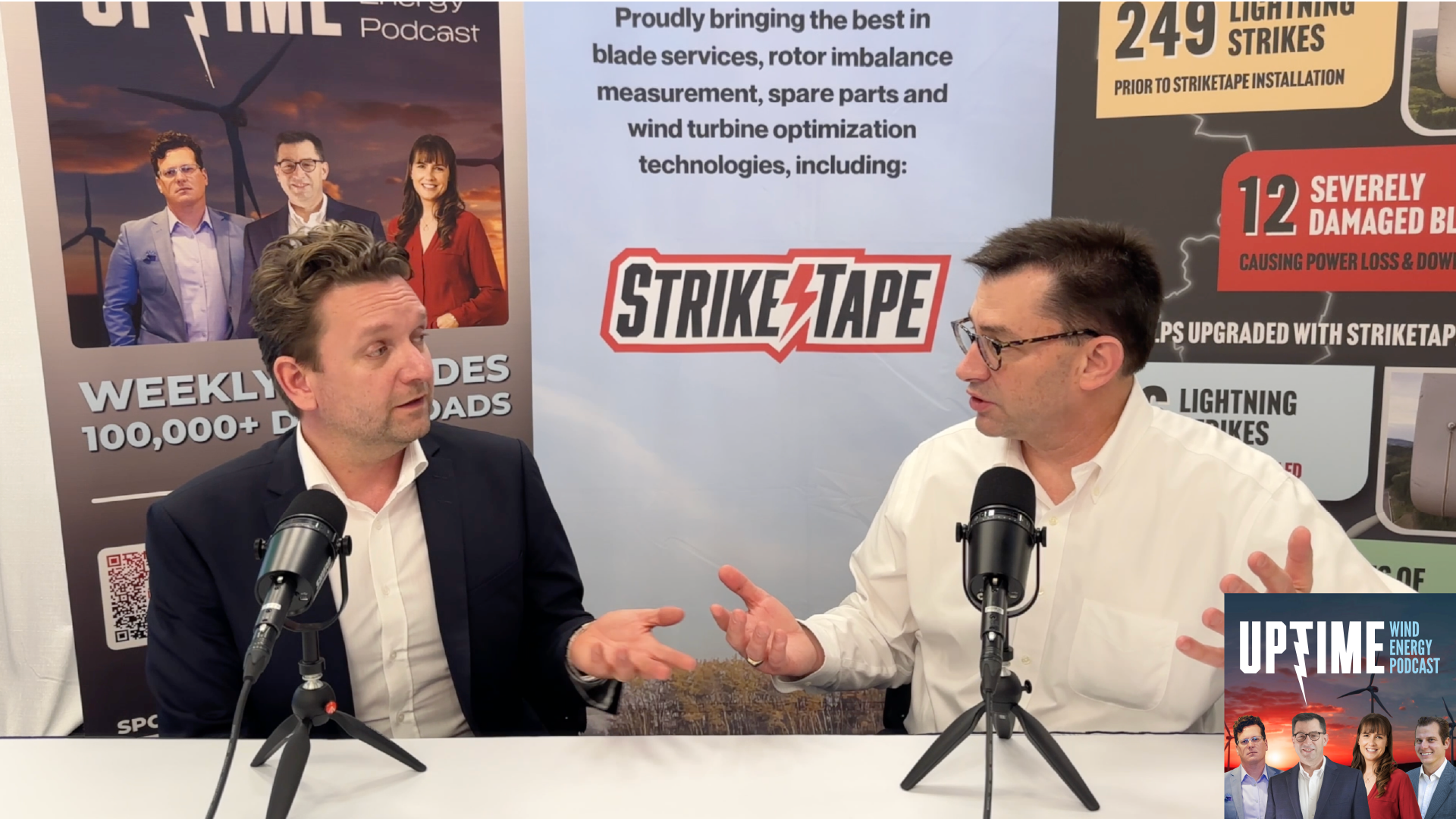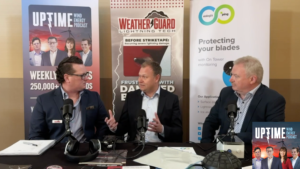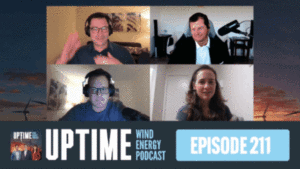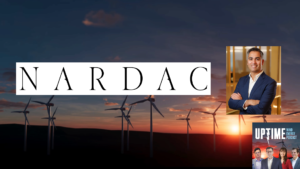Podcast: Play in new window | Download
Allen Hall interviews Anders Røpke, CEO of Wind Power LAB, about their innovative software product, LASSIE. LASSIE helps wind farm operators detect and mitigate lightning damage to their turbines by analyzing global lightning data and providing alerts when turbines may be at risk. With its affordable subscription model and seamless integration, LASSIE offers a cost-effective solution for protecting wind farm assets and maintaining a prudent operational track record. Visit https://lassie.windpowerlab.com/ for more information!
Sign up now for Uptime Tech News, our weekly email update on all things wind technology. This episode is sponsored by Weather Guard Lightning Tech. Learn more about Weather Guard’s StrikeTape Wind Turbine LPS retrofit. Follow the show on Facebook, YouTube, Twitter, Linkedin and visit Weather Guard on the web. And subscribe to Rosemary Barnes’ YouTube channel here. Have a question we can answer on the show? Email us!
Pardalote Consulting – https://www.pardaloteconsulting.com
Weather Guard Lightning Tech – www.weatherguardwind.com
Intelstor – https://www.intelstor.com
Allen Hall: Welcome to the Uptime Wind Energy Podcast. I’m your host, Allen Hall, and I have a special guest today, Anders Røpke, who is the founding partner and CEO of Wind Power LAB, which is based in Copenhagen, Denmark. And Wind Power LAB is an expert on blades and things around blades, but we’re here today not to talk necessarily about blades directly, but we’re here to talk about lightning protection and lightning detection and what operators can do to make their Wind farm, less susceptible to big lightning damage.
Yeah, that’s Anders, well, welcome to the program.
Anders Røpke: Thank you very much. Thank you for having me, uh, I’m sure.
Allen Hall: So we’re, we’re in San Diego, which the weather’s a lot better than Copenhagen at the moment. Uh, I was in Copenhagen a week and a half ago, two weeks ago. It was snowing, cold, miserable, and here it’s nice and sunny, and there’s a beach, and it’s, it’s not a bad place to be.
So we’re at, uh, ACP OM&S and talking all things, of all things, lightning. And so Windpower LAB has developed a new, it’s basically a software product or an app, so to speak. It’s called LASSIE.
Anders Røpke: It’s called LASSIE, like you know the watchdog. Yes. Because we need something or someone to take care of our wind turbines.
Yes, we definitely do. And as you could tell earlier in the week here in California, you had really poor weather. Horrible weather. Thunderstorms and whatnot. And let’s bring out the elephant in the room, the lightning. Lightning issues, right? And, um, with this product of ours, our offering is, you know, you can simply just go out and inspect the turbines that is in risk.
Yes. And, um, how is that possible? Well, we use, it’s a global solution. It’s something you can just add coordinates of the turbines to the system. And by doing that, you’ll get an overview of the relevant lightning strikes within the area where you have your turbines. Right. Yes. So let’s say you have. In the States, wind farms are huge, 500 turbines, which one should I inspect after this, after the lightning storm?
Allen Hall: Big, great question to have.
Anders Røpke: So it might be in the Southeastern part of the wind farm, right? But again, why should you do it? And hopefully the turbine survived the thunderstorm because they’re designed for it, but let’s go check anyway. So we can pinpoint where to go and check. You get a work order list, you get all the relevant, uh, lightning data information.
And then we relate this to the IEC standard and the blade type, the LPS system you have installed. Do we have any certain risk on those specific turbines you should address? That’s a good insight.
Allen Hall: Okay, so the LASSIE system is taking some of the global lightning network data and saying, okay, we know where the lightning strikes occur.
And if I belong to this lightning, the LASSIE system, I input my turbine coordinates to So here’s where all my turbines are. And lastly, then just is it like a watchdog? It just sits there and watch for lightning strikes that happen around those turbines. Okay, great. But on top of that, it’s saying this particular turbine has a susceptibility of X and you, but this lightning strike may have triggered that.
Let’s go take a look.
Anders Røpke: Exactly. So you could, um, You could explain this by, uh, thinking of you being the flight controller in a huge airport, right? Yes. So, we have clients where they have maybe 30 different, uh, wind turbine types. Easy, yeah. And that’s all fine, but they need to look across, and some of those turbines they have in their operational fleet will be more prone to damages.
Allen Hall: Sure.
Anders Røpke: That’s the basic fact, and some of them you don’t have to pay that much attention to.
Allen Hall: Right.
Anders Røpke: True. Nevertheless What you would like to build here is a track record that you are taking good care of the wind turbines. Because you are defending your asset value. Yes. Right? You can get your wind farm insured.
Yes. And if you can get it insured, you can get it financed. Right. So everyone is happy.
Allen Hall: So that’s a unique product because the LASSIE system doesn’t require any hardware. No.
Anders Røpke: It’s no sensor, locally installed. Okay. So, um, we use the global data networks. Yeah. That your insurers and risk engineers and everyone else would use.
But the secret sauce here is that we relate it to the blade specific information. And the IEC standard. Yeah. So, as an operator, by using the platform, you can become a prudent operator. Because according to the IEC standard, it’s recommended to inspect if you have a lightning strike within three times hop height of your turbine.
Allen Hall: Right. That’s how easy it is.
Anders Røpke: Show that you are always doing that. Show that to your insurer. Right? Sure. Then, I won’t say you will get a reduced premium, but at least you can get your insurance to cover, right? That’s a good argument. Because you are actually in control and cost wise you will be in control because if you for some reason have a, a damage, then you’ll find it in time and not just wait until your statutory inspection will find it in maybe two years time.
Allen Hall: Yeah, and I think that’s the big issue in the United States and in Italy, Greece, Croatia, uh, uh, Brazil, where lightning is a big problem, what tends to happen is you do a drone inspection once a year, roughly, sometimes twice a year, but sure as anything, you do the drone inspection, the next week you take a strike, take damage, and then it sits there, because you just don’t have the resources to go out and check, and the storms in America are so massive at times, you’d end up, if you just.
if you just looked at the lightning data by itself, you would say I have to inspect every turbine on the farm. That’s insane, right? And technicians don’t do it because that’s what they’re asked to go do, and that’ll take forever. So lastly focuses the technicians effort to save time, but also to look to the things that are probably the hot spots so you can catch them.
Anders Røpke: So the way we have done this is that Every single wind farm should of course have a blade maintenance strategy. Right. And part of that blade maintenance strategy is how do you handle lightning activity. Sure, sure it is. You have a lot of lightning activity or less, really doesn’t matter here. Right. But if you tailor this the correct way inside the system, then you can configure the blade type and then tailor your lightning strategy if you like to actually capture as much as possible.
Of course, no one can capture everything, but, uh, remember that insurance is for the unforeseen event. And if you’re checking based on the data available, where you mobilize or prioritize it, simply on probability, right? And you do your best, then, I mean, then, then you’re You’re being a responsible operator.
You’re being responsible and I think, uh And smart. It is and it’s, uh, yeah. It’s gonna save you money. It will save you, like, uh, maybe a factor 5, factor 10, if you capture such a, uh, lightning damage in time.
Allen Hall: Wind Power LAB is the perfect case, because you guys know, from all your experience of looking at damaged blades, that lightning damage has been out in service for too long.
Anders Røpke: Yes, and we see so many unnecessary damages, if you like, so something that could have been repaired for maybe 5, 000 to 10, 000, which is, of course, a lot of money. But if you wait, it can turn into 100, 000 quickly. Yeah. And for a small fee, you can put your turbines up on subscription instead, and then get a heads up when you need to go and inspect and verify everything is fine.
Allen Hall: Okay, so if I’m an operator, let’s walk through this process. I’m an operator. I’ve had lightning damage. I have no way of really detecting what to go inspect. What are the steps here to get hooked into lasting? What do I do? And what does that process look like?
Anders Røpke: So first of all, you can reach out to me. Okay, sure.
No, but we need to get you started on the, on the software. So for your wind farm, we would need a coordinate per turbine. So we need to know where in the world your turbines are located. And if you can tell us which blade type you have, or just the wind turbine type, then we have come a long way.
Commissioning date would also be nice to know.
Allen Hall: Sure.
Anders Røpke: But the point is that they will plug you into our system. Then we will roll back time for two or three years. We’ll do a historic data analysis of strikes. Oh, okay. And based on that, you will get like a decisionality of the frequency of sharks, the intensity, what is going on.
Then you’re actually ready to go for the, yeah, in a moment you have the lightning season again here and then you’re ready to go and then you can compare to last season. But this time around, you can actually. Through your work order lists here, verify that nothing happened. And that’s the track record.
That’s worth a lot of money.
Allen Hall: That is. So, I get my coordinates in the system. I’m in the system, on the LASSIE system. I can just log into that on a desktop computer, laptop?
Anders Røpke: Laptop, phone, whatever you need. Okay, so it’s on the phone too? Yeah. Okay. And then you get notified by email, if you like. Okay. Now you need to, uh, to attend your turbines.
Allen Hall: So when a storm comes through, I get an email alert saying, these turbines I need to go take a look at because they may be at risk or because the lightning is really close to them. And then that gets registered. So you, not only are you adding the historical data, you’re taking the new data and adding it to aggregate it.
So you have a understanding of what the lightning history is for that particular turbine.
Anders Røpke: Exactly. Okay. So, so you will like have a, it’s a small workflow. So, you know, in here you’ll have. These are the observations. These are your warnings. Then you go through the data. Okay. Not the data data, but, I mean, you go in on an alert basis.
Right. And from the top, you will then pick and choose which ones to attend to. Okay. Then you go out and check. You take your picture if something happened. Sure. And then it will all be registered. That you have actually attended to that specific lightning event.
Allen Hall: Okay. So you can take the pictures of the blade and put it back into the LASSIE system.
So it’s like a history lesson of that particular turbine.
Anders Røpke: And now if, if, if we should, um, you know, then what, what about this track record you’re building over the course of the season? Right. If you have your renegotiation of your policy insurance policy for the next season, then let’s say in December, you roll it all out and you have your And you can have a educated discussion with your insurance company.
Yes, we have a, let’s say huge lightning risk in my area, but it’s not that bad actually. We had 117 strokes inside the relevant part of the wind farm. Sure. But according to the IEC standard, I did what I could to inspect. Right. And out of the 117, I found maybe five damages, but the good news is I got to repair them in time.
And you’re caught. That’s the prudent of a way. That is a prudent operator. And that’s also the one that you would like to have on your insurance policy.
Allen Hall: Sure. And because you can implement LASSIE very easily, you can be up and running in a matter of a couple of hours, it sounds like, a day.
Anders Røpke: Yeah.
Allen Hall: Yeah, you can be up and running for a whole farm, or farms.
Yeah. That, that is a subscription model, or is it a something you purchase? What, what’s the financial setup?
Anders Røpke: Yeah, we have made it simple. No megawatts or anything. Okay. It’s a dollar a day. Oh, a dollar a day. Off you go.
Allen Hall: Okay, so for a dollar a day, I can track my turbines, wherever they are, anywhere in the world.
Yes. And you have a dashboard, so to speak, that tells me what the health of that turbine is.
Anders Røpke: Okay. Thunderstorm by thunderstorm. Thunderstorm, okay.
Allen Hall: Yeah. And it gives me alerts and things go sideways.
Anders Røpke: And inside the platform, of course, you can, if you’re an asset manager with the responsibility of one wind farm, that’s your view.
But if you have the overall responsibility, you can get it fleet wide as well. So from this, you can actually tell which wind farm is, you know, the worst, the best performing and so forth.
Allen Hall: You could take your technicians and focus them on the problems at hand. It’s not just spreading around searching for issues.
Anders Røpke: And and of course, we know a lot of other work orders needs to go through We also integrate to other Asset management platforms, so we feed that in Through an API so you can get access to the data if you’re using Another system for handling all your activities on site.
Allen Hall: So if you have like a SkySpecs system where you have a data collection
Anders Røpke: base field or
Allen Hall: right, there’s a whole bunch of them right now, so yours will just plug into that existing other platform.
Anders Røpke: Because we are so blade centric on this one shirt with respect to the lightning risk. And so we, I would say we are kind of the expert software and then that is being translated into a work order.
Go check.
Allen Hall: Got it. Okay, wow. That’s a really interesting piece of technology. So that, that is very useful. I do think a lot of operators all around the world have issues with Lightning, but they don’t have a quick way to get something implemented and to start tracking it, which is the problem. And they’re, they’re behind.
So if you’re going back in time to give them a history, that really helps them understand the scope of the problem they’re dealing with.
Anders Røpke: At least it gives you some kind of magnitude, right? Right. And of course you could also do this on your own. Get a subscription with one of the data providers. But that’s super expensive.
It is.
Allen Hall: I see those numbers are astoundingly big. For a dollar a day, you’re much better off doing a LASSIE system. Because it’s the same data. It is. And it’s tailored to you. And your blades. And your blades, exactly. Wow. Okay, that’s fascinating. This has been really interesting. How do people find out about LASSIE?
Where do they go? How do they connect with you?
Anders Røpke: Yeah, so you can go on LinkedIn and of course look me up. If you can spell to my last name, . Um, otherwise go to windpowerlab.com. Yeah. Or we have a dedicated website called LASSIEwatchdog.com.
Allen Hall: LASSIEwatchdog.com. Okay. That should be easy.
Anders Røpke: Then, uh, you can get in touch and, uh, what we would ask from you is a couple of coordinates and then we set up a meeting and, uh, you can see for yourself on your own turbines.
Allen Hall: Wow. Okay. Useful technology. This is really cool. We always like having things on the podcast that are actionable that can change the direction of an operator. This just sounds like one of them. So Wind Power LAB at it again. This is cool.
Anders Røpke: Thank you.
Allen Hall: Anders. Thank you for being on the podcast. I appreciate it.
Yeah. And if you have any issues with lightning, then you need something that gets up and running so you can get better understanding of what you’re up against. Reach out to Anders here, winch at the Wind Power LAB and check out the LASSIE system. Really cool. Thanks for being on the program.











